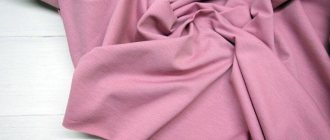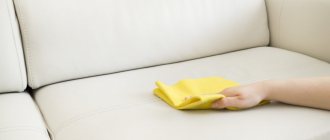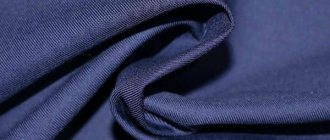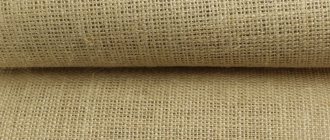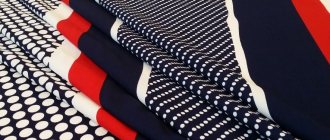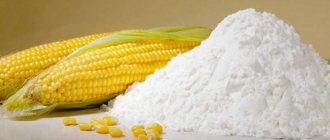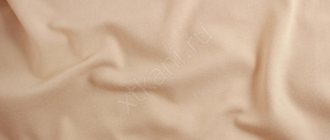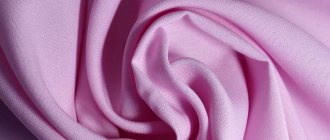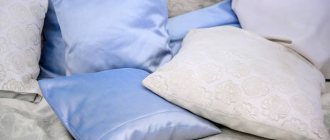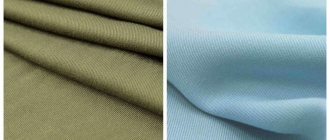Each fabric has its own set of characteristics, depending on the fiber used, the type of weaving, thread parameters and manufacturing technology. Based on the properties, the scope of application of the material is determined: will it be universal, for all occasions, or will it occupy a narrower niche. One of these narrowly targeted fabrics is staple, which in no way detracts from its advantages or reduces its popularity.
It is not known exactly where the staple first appeared, but in the last century it was at the peak of its popularity in the Soviet Union. And even now there is a consistently high demand for it. What it is? What kind of fabric is this?
Staple - description, properties, composition
The material has a traditional plain weave, but shortened fibers are used. The raw material can be waste from the production of other fabrics, where only long fiber is needed. The staple is quite dense, but thin and light, drapes well, with a pleasant-to-touch surface. A little like wool, but softer and more delicate. It has good stretch and is stretchy enough to fit and hold its shape. People's love for the fabric was ensured not only by its availability, but also by other advantages. Description of properties:
- Wear-resistant - does not fade, does not fade, does not stretch. The colors are like new after multiple washes.
- Decorative - manufacturers offer hundreds of colors, there is plenty to choose from, and the silky surface ensures a decent appearance of things.
- Hygroscopic - absorbs moisture well, cooling the skin.
- Permeable – allows air to pass through, allowing the skin to breathe freely without steaming, even on a hot day, giving a feeling of coolness and comfort.
The bulk of our mothers' and grandmothers' robes were made from staples. It always had bright colors and a cheap price, so at every opportunity the material was collected by the meter.
The classic composition of the staple is a 50/50 mixture of natural cotton fiber and viscose obtained from wood pulp.
Less common was a ratio of 60% cotton and 40% viscose. To add elasticity, lavsan began to be added to the staple, but in a much smaller proportion: 50% cotton, 30% viscose, 10% lavsan. Today's manufacturers freely interpret the recipe; you can also find a completely cotton staple or with a slight admixture - 80% cotton and 20% viscose or lavsan.
Many people are interested in the question: what kind of viscose fabric is it - natural or synthetic? We recommend that you learn more about the properties of the viscose fabric in this material.
Production Features
The chemical composition of staples does not differ from long threads. For their production, chemical fibers of artificial or synthetic origin are used. It can be viscose (cellulose), cellulose acetate, polyamide, polyester, polyvinyl chloride, polypropylene, molten inorganic glass.
Stages
- First, prepare the spinning solution. Technology depends on raw materials.
- It is then passed through special large spinnerets with many more holes than in the production of regular length threads.
- Fine continuous streams flow from the dies, which harden using a dry or wet method.
- Threads from several spinnerets are collected into bundles.
- Using a special machine, these bundles are cut or torn into pieces of a certain length. When slicing, the resulting pieces are the same length, but when torn, the length may turn out to be uneven.
- After this, the staples go through the finishing stage and become white, colored, shiny or matte.
Application - what can be sewn from material
As before, the staple is a sought-after raw material for the light clothing industry; it produces beautiful, comfortable and durable wardrobe items.
- Summer children's clothing;
- Women's summer sundresses, dresses, skirts, blouses;
- Men's summer shirts;
- Casual clothing: robes, dresses;
- Summer night pajamas.
Almost any clothing intended for the warm season can be sewn from staples. It does not fade in the sun at all, pleasantly cools hot skin, and looks beautiful.
Due to the popularity of the material, the staple began to be often counterfeited, passing off as low-quality, synthetic fabrics. You shouldn’t be fooled by too low a price; given its availability, a linear meter costs at least 250 rubles. In addition to domestic producers, high-quality staples are supplied by Korea, Türkiye and Indonesia.
Find out what is better: holofiber or padding polyester.
Reviews of percale fabric: .
Here you can see a photo of roller blinds for a window with a balcony door.
How is staple fiber used?
Various textiles are produced from woven materials: men's, women's and children's clothing of various groups (from home to outerwear), underwear, home textiles, technical fabrics. A mixture of natural, synthetic and nylon staple fibers creates heat-resistant fabrics that are abrasion resistant, but soft to the touch and have good hygienic properties. Work and protective clothing are made from such fabrics.
In addition to yarn for various fabrics and knitwear, non-woven materials are made from staple fiber. For this purpose, various bonding methods can be used: chemical or adhesive, thermal and mechanical (needle-punched, pierced or water-jet bonding).
Nonwoven materials can be flat or voluminous and are used in a wide variety of industries:
- In medicine. They are used to make disposable clothing and hygiene products.
- In road construction. They are made for drainage or load-distributing foundations.
- In civil and industrial construction. Glass staple fiber is distinguished by a rare combination of qualities: high tensile and compressive strength, non-flammability, low hygroscopicity, chemical and biological inertness. Materials made from it are excellent sound, steam and heat insulators.
- In the textile industry. Staple polypropylene fiber serves as raw material for the manufacture of filling for outerwear, blankets, travel equipment (sleeping bags), etc.
© 2021 textiletrend.ru
Types of staple fabric: mixed, cotton
Staple comes in two main types, depending on the composition:
- Blend (classic) – composed of cotton with viscose, possibly containing lavsan. Usually, this is a domestic material; we have plenty of viscose in our country, but with cotton it’s worse.
- Staple cotton (cotton) is pure 100% cotton. It allows air to pass through better and does not cause irritation to even the most sensitive skin. Disadvantages include loss of elasticity and severe creasing. Such a staple is usually imported; with foreign partners everything is fine with cotton, but with viscose they are strained, and the technology is lame. You can learn about elastic cotton material in this article.
Despite the existing shortcomings, cotton staple wins in terms of tactile sensations and appearance. Using one type of fiber allows you to obtain a thinner, lighter and softer fabric with a perfectly smooth surface.
The art of sewing
Home » Material selection » Staple fibers
Chemical fiber can be obtained in the form of twisted threads of infinite length (silk threads) or in the form of short fibers of a certain length - staple fibers.
Staple fiber (from German Stapel - fiber) is a chemical fiber obtained by cutting or tearing a bundle of longitudinally folded elementary threads into pieces 40-70 mm long (called staples).
Preparation of staple fiber
To obtain staple fiber, spinnerets with a significantly larger number of holes are used than for spinning artificial silk threads. If spinnerets with 24 - 100 holes are used to produce complex threads, then when producing staple fiber the number of holes in the spinneret reaches 2000 - 12000, which causes a significant increase in the productivity of the spinning machine.
The threads collected together from several spinnerets form a bundle. The bundles consist of a very large number of elementary threads (hundreds of thousands) and are stapled on special machines into separate sections - fiber lengths depending on the purpose.
Stacking is done by cutting or breaking the threads in the bundle. The first method has a number of advantages, since it makes it possible to obtain fibers that are more uniform in length and without excessive internal stress.
The length of the staple fiber is adjusted to the length of the cotton, flax or wool fiber if it is to be used in the mixture.
Use of staple fiber
Staple fiber is used to produce yarn and non-woven fabrics. Yarn from staple fibers is used to make fabrics and knitwear. Materials made from staple yarn have less shine, better heat-protective and hygienic properties, and are more pleasant to the touch due to their softness and fluffiness than materials made from filament yarns of the same origin.
Spinning of staple fibers can be carried out using cotton spinning equipment using a card spinning system or a staple system from a tow of elementary chemical threads.
Yarn made from staple fibers has greater uniformity than yarn made from natural fibers.
Textured (highly elastic) yarn is obtained from mixtures of multi-shrink chemical fibers.
Staple fiber is used not only in its pure form, but also in a mixture with other fibers, and goes through the entire cycle of operations with these fibers at the spinning mill.
The addition of synthetic fibers to natural ones improves the mechanical properties of the yarn and increases its wear resistance.
Tags: fibers, spinning, yarn, chemical fibers, staple, staple fibers
Published by Larisa Klepacheva on June 7, 2010. Posted in Select materials. Tags: fibers, spinning, yarn, chemical fibers, staple, staple fibers.
Previously in the same section:
- Characteristics of indicators and analysis of places of wear of products made from natural fur // April 22, 2012 //
- General scheme of weaving production // April 16, 2012 // 1
- Assortment of materials for dresses // April 10, 2012 //
- Sliding and fraying of edge threads in fabrics, impact on clothing production processes. Instruments and methods for their determination. Part 1 // April 2, 2012 // 2
- Synthetic fibers // June 1, 2010 //
Leave a comment or two
Click to cancel reply.
Staple care
Being natural, the material has its own characteristics that must be taken into account when caring.
- Wash on a delicate cycle or by hand, at temperatures up to 40°C. When choosing a detergent, you should give preference to gentle ones that do not contain aggressive substances.
- to squeeze it out with your hands, carefully, since the staple can be easily damaged when wet.
- Iron from the wrong side, preferably through gauze or other fabric.
The staple is characterized by noticeable shrinkage, you should not buy a tight-fitting item, after washing there is a chance that it will not fit into it.
If you are sewing yourself, first rinse the cut in cool water and dry it. Iron the slightly damp fabric without stretching it with a warm iron. After such manipulations, it is easier to cut, and in the finished form, if the product shrinks at all, it will shrink slightly.
Find out how to attach roller blinds to plastic windows.
Here you can see a photo of flock fabric.
Approximate prices for orthopedic pillows for children: .
Reviews
The staple has been loved by many since childhood, from the times of short sundresses, panama hats and robes. They speak of it as a beautiful, high-quality material, but if someone runs into a fake and is disappointed, it’s not the staple’s fault, but the businessmen’s.
My favorite summer staple items are that they don’t fade, they always look great, and they’re not so hot in the hottest days. I try to buy material that contains both cotton and viscose; it wrinkles less and drapes better.
Olesya
I love to sew, but I took up this recently, with little experience and skills. I decided to sew a simple robe, I bought a bright material that was pleasant to the touch, thin and light. Well, a friend came to visit, she knows better about fabrics. It turns out that I took a swing at the staple, and the newcomer will have to fight with it. With a joint effort, the robe was sewn, but there was some fiddling around. True, it was worth it, and the body breathes, and it turned out beautifully, and the price is normal.
Lara
Before going to the resort, I decided to update my wardrobe and bought several light sundresses and robes. I took it based on appearance, didn’t think about the fabric, touched it, it seemed soft. I thought, as usual, everything would fade and lose its appearance, I was pleasantly surprised when, after active wear and constant washing, the things remained bright and retained their shape. I read the labels, it turns out that this is a staple, now I will always choose this durable material for the summer.
Dasha
The staple lives up to the expectations placed on it if you pay attention to proper care. This is a beautiful, sustainable material made from natural fibers that is comfortable for the body. Also read about the material with memory properties - cotton memory at the link.
You can find out about the fabric that imitates silk - bengalin here.
